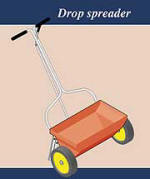|
Lawn care is one thing that should be
on everyone's mind. It's hard to get cranked up much about it when
there is snow, but timing in the spring is critical for some
operations. Let's start with crabgrass control. Crabgrass is an
annual grass, meaning it comes up from seed every year. One of the
best ways to control annual weeds is to use a seed germination
inhibitor that works on that germinating seed. The only problem is
timing. These herbicides must be put on before you see the weed --
in this case the crabgrass.
Many of the germination inhibitors are combined with fertilizer.
They should be applied about April 1 in our area, but the timing can
vary a couple of weeks. The crabgrass seed germinates on the basis
of soil temperature, but one of the good indicators is forsythia in
bloom. If you don't have your crabgrass preventer on by the time you
see forsythia blooms, you had best get it on quickly.
 Another thing to keep in mind is
that the same product that prevents crabgrass from germinating will
do the same thing to other seeds. This means that you can't sow new
grass seed and use a crabgrass treatment at the same time of year.
If you need seeding done, fall seeding is actually the best. Another thing to keep in mind is
that the same product that prevents crabgrass from germinating will
do the same thing to other seeds. This means that you can't sow new
grass seed and use a crabgrass treatment at the same time of year.
If you need seeding done, fall seeding is actually the best.
Grass may be sown either March 15 to
April 1 or Aug. 15 to Sept. 10. Spring seedings don't usually have
the success that the fall ones do, because hot weather tends to hit
before lawns become well-established.
Seeding rates should be about 4
pounds of seed per 1,000 square foot for bare dirt and half that
rate for overseeding thin areas. We recommend using a blend of
grasses, such as Kentucky bluegrass, a fine fescue and perennial
ryegrass. Some people leave out the perennial ryegrass, but it does
provide quicker germination and some wearability.
[to
top of second column in this article]
 |

The seeding times are also good times
to use a plug aerator or a power dethatcher. These operations are
very hard on grass, and doing them when the grass recovers quickly
goes a long way to keeping your lawn healthy. Both of these
operations are usually done to help remove thatch layers. This
thatch should be no more than one-half inch in depth or you'll tend
to have disease problems come in.
Fertilizer and broadleaf weed
control are best applied in May, when they work better. This early
in the season, lawn weeds aren't actively growing, and turf isn't
growing actively enough to make good use of nitrogen fertilizer.
Many broadleaf weedkillers need temperatures over 50 degrees to work
properly.
Another item I am getting several
calls on is grubs and moles. The two are often related. Moles eat
grubs and earthworms for food.

This really isn't a good time to try
to control grubs, since they are large in size and won't be around
too much longer. They will pupate this spring and come back out as
June bugs, Japanese beetles or green June bugs to start the process
all over again. The best control time is from August through
September.
Mole control is best accomplished by
doing away with their food source, so they go elsewhere. With this
not being a good time for grub control, you are reduced to trapping
for moles. The loop-type traps work better than the harpoon types.
Hopefully these spring lawn tips
will get you started on the right track for the year. If you have
further questions, feel free to contact the office at 732-8289.
[John
Fulton, unit leader,
University of Illinois Extension,
Logan County Unit] |

